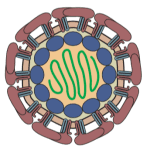

The most recent evidence comes from a case report of an 81 year old French man who developed meninogoencephalitis 10 days after returning from a 4 week cruise to New Caledonia, Vanuatu, Solomon Islands, and New Zealand (meningoencephalitis is infection of the meninges – the membranes that cover the brain – and the brain). His symptoms included fever, coma, paralysis, and a transient rash. A PCR test revealed Zika virus genomes in the cerebrospinal fluid, and infectious virus was recovered after applying the CSF to Vero cells in culture.
A second case report concerns a 15 year old girl in Guadeloupe who developed left hemiparesis (weakness of one side of the body), left arm pain, frontal headache, and acute lower back pain. After admission she developed dysuria (difficulty urinating) that required catheterization. PCR revealed the presence of Zika virus genomes in her serum, urine, and cerebrospinal fluid; other bacterial and viral infections were ruled out.
Until very recently Zika virus was believed to cause a benign infection comprising rash, fever, joint pain, red eyes, and headache. There is now strong evidence that the virus can cause congential birth defects, and growing evidence that the virus is neurotropic and neurovirulent. Previously the entire Zika virus genome was recovered from brain tissue of an aborted fetus.
Zika virus is classified in the family Flaviviridae, and other members are known to be neurotropic, including West Nile virus, Japanese encephalitis virus, and tick-borne encephalitis virus. West Nile virus infection may lead to acute flaccid paralysis, meningitis, encephalitis, and ocular manifestations. Examination of additional cases of Zika virus infection will be needed to document the full spectrum of illness caused by this virus.
Update: Neurotropism of Zika virus is also indicated by the findings that the virus infects human cortical neural progenitors.
